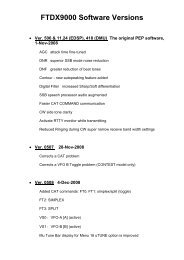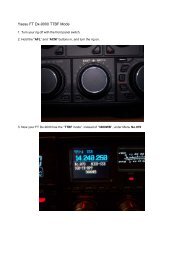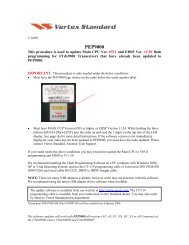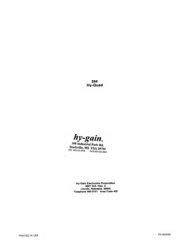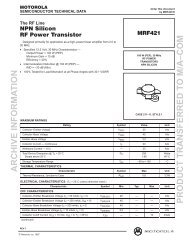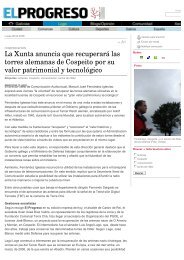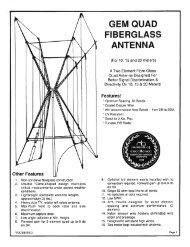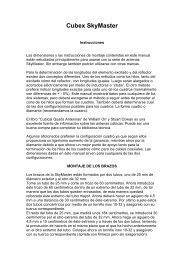Now cover 1296 MHz - EA1DDO
Now cover 1296 MHz - EA1DDO
Now cover 1296 MHz - EA1DDO
You also want an ePaper? Increase the reach of your titles
YUMPU automatically turns print PDFs into web optimized ePapers that Google loves.
<strong>Now</strong> <strong>cover</strong> <strong>1296</strong> <strong>MHz</strong><br />
TransFox Highlights<br />
• General <strong>cover</strong>age 1-1450 <strong>MHz</strong><br />
• Outstanding LO resolution (1Hz), phase noise & lock times thanks to SynFox technology<br />
• Brings unique VHF, UHF and SHF <strong>cover</strong>age to SDR<br />
• SDR demodulation and modulation with sound card ( I/Q)<br />
• Compatible with existing Windows or Linux software in addition to specific SigFox<br />
software<br />
• FFT spectrum analysis<br />
1 Hz tuning resolution through conventional ”fixed filter/agile LO” operation, or SDR<br />
“mouse tuning” operation<br />
TransFox is an SDR (Software Definable Radio) transceiver, based on the SynFox High Resolution<br />
Multi-Accumulator Fractional-N synthesis. It is available in receiver or receiver/transmitter<br />
configuration <strong>cover</strong>ing 1<strong>MHz</strong> to 1450 <strong>MHz</strong>. Frequency plan can be extended beyond existing<br />
frequency range upon agreement., and some additional and unique options, “ruggedness options” or<br />
“robustness options” are either available or in preparation.<br />
TransFox, being based on SynFox, exhibits outstanding performance of high resolution (1Hz steps),<br />
low phase noise (Better than -100dBc/Hz @ 1kHz) with very short lock times (40us for 1<strong>MHz</strong> step).<br />
Main advantage of High Resolution Frac-N synthesis, is a low phase noise associated with low<br />
consumption, and this, particularly in regions far beyond DDS traditional <strong>cover</strong>age limit (200 <strong>MHz</strong>).<br />
Thus, SigFox technology widely opens the VHF, UHF and SHF space to SDR, where other SDR<br />
radios are confined in the HF region.<br />
An other advantage of high resolution, is the possibility to still “physically” tune or “AFC” the signal<br />
within a given “fixed” filter, and thus come back to the “fixed filter / agile LO” method used on<br />
conventional receivers, in addition to the “mouse tuning” by digital complex multiplier brought by<br />
SDR. Most of the HF SDR can’t do this, because using fixed LO’s in order to achieve a good noise.<br />
Although digital “mouse tuning” is the usually preferred method in SDR, physical tuning can<br />
allow to further improve robustness up to outstanding level by adding a crystal filter option to<br />
TransFox, while keeping many advantages of SDR.<br />
RFPA-RFham Parc d’activites Fontaudin Avenue Descartes 33370 Artigues pres Bordeaux France<br />
Ph. +33 557 54 04 66 Fax +33 556 86 55 56 E-mail : contact@rfham.com
General<br />
Parameter Unit Value Comment<br />
Minimum frequency <strong>MHz</strong> 1 With 10 dB NF degradation<br />
Maximum frequency <strong>MHz</strong> 1450<br />
Minimum frequency<br />
step<br />
Hz 1.16 1 Hz software interpolation<br />
All other kind of steps configurable by<br />
Software<br />
Supply voltage V 12 Nominal voltage for full frequency<br />
<strong>cover</strong>age<br />
Supply voltage V 12 Partial voltage leading to partial<br />
frequency <strong>cover</strong>age depending on<br />
voltage.<br />
All other parameters equal.<br />
Max Supply voltage V 14.5 Max<br />
RF connector<br />
Ohms 50<br />
impedance<br />
Reference frequency <strong>MHz</strong> 26 TCXO in standard<br />
Frequency stability ppm 2 With standard TCXO<br />
Frequency stability ppm 0.1 With standard TCXO and software<br />
temperature compensation<br />
Frequency stability ppm 0.01 With optional OCXO<br />
TX Output power dBm HF +10dBm, Typ.<br />
+/- 1.5 dB over band<br />
+17dBm<br />
50 <strong>MHz</strong> + 10dBm,<br />
Typ. +15 dBm<br />
144 <strong>MHz</strong> +10dBm<br />
Typ. +15 dBm<br />
432 <strong>MHz</strong> +10 dBm<br />
Typ. +15dBm<br />
<strong>1296</strong> <strong>MHz</strong> + 5dBm<br />
Typ. 10 dBm<br />
Phase Noise dB/ Hz Typ : -105 dBc / Hz Depending of the sound card<br />
Discrete Spurious dBc -80 ∆F > 600 KHz<br />
Harmonics dBc -20 Absolute min with no tracking RF filter<br />
option<br />
Settling time µs 500 typ 10 <strong>MHz</strong> step<br />
Settling time µs 40 typ 1 <strong>MHz</strong> step<br />
Receiver<br />
Parameter Unit Value Comment<br />
Noise figure dB 4 Max over 5 to 1450 <strong>MHz</strong> band<br />
FM sensitivity dBm -116 Typ 11F3 for 20 dB sinad, CCITT filter<br />
on<br />
SSB sensitivity dBm -125 Typ for 10 dB S/N, CCITT filter on<br />
PSK30 sensitivity dBm -148 Typ at 100 Char/min<br />
FM “11F3” Cochanel dBc -8 Typ for 11F3 FM (depends on SW)<br />
SSB Cochanel dBc -5 Typ for 2.5 KHz SSB<br />
PSK30 Cochanel dBc -3 Typ for PSK30<br />
FM “11F3” Minimum<br />
Selectivity<br />
SSB Minimum<br />
Selectivity<br />
dBc 52 Min for 11F3 @ +/- 150 KHz from<br />
carrier (selectivity dominated by LO<br />
phase noise)<br />
dBc 61 Min for SSB @ +/- 150 KHz from<br />
carrier (selectivity dominated by LO<br />
phase noise)
PSK30 Minimum<br />
Selectivity<br />
I/Q image rejection dBc 40<br />
70<br />
Blocking dBc 72<br />
81<br />
100<br />
dBc 80 Typ for PSK30 @ +/- 150 KHz from<br />
carrier (selectivity dominated by LO<br />
phase noise)<br />
Min without calibration<br />
Typ with multipoint calibration<br />
Depending of quality of sound card<br />
use<br />
FM @ +/- 1.5 <strong>MHz</strong> beside carrier<br />
SSB @ +/- 1.5 <strong>MHz</strong> beside carrier<br />
PSK30 @ +/- 1.5 <strong>MHz</strong><br />
(Dominated by LO phase noise)<br />
Typical IMD3 dBc 70 Typ, measured in 11F3<br />
IP3 dBm +2 Typ<br />
1 dB comp point dBm -15 With max RF gain<br />
1 dB comp point dBm +25 With AGC options<br />
RF Image rejection dBc 60 Up conversion<br />
Half IF response dBc 60 458.25 <strong>MHz</strong><br />
2 x IF response dBc 75 min<br />
IF response dBc N/A Depends on RF filter options<br />
Maximum usable<br />
baseband<br />
Recommended<br />
baseband and A/D<br />
conversion<br />
KHz +/- 300 600 KHz maximum baseband spectrum<br />
available in I/Q mode depending of<br />
software and sound card use<br />
KHz<br />
Ksample/s<br />
Resolution in<br />
bits<br />
+/- 100<br />
200<br />
20 or 24<br />
Power consumption mA RX: 450mA<br />
TX: 530 mA<br />
200 KHz baseband spectrum<br />
depending of software use<br />
16 bits possible but with final dynamic<br />
limited to around 85 dB<br />
Typ @ 12V, 25°C<br />
Transmitter<br />
Parameter Unit Value Comment<br />
RF output Spurious dBc -40 max Depends on RF filter options<br />
RF output Spurious dBc -60 max With tracking filters<br />
Output power dBm HF +10dBm, Typ.<br />
+/- 1.5 dB over band<br />
+17dBm<br />
50 <strong>MHz</strong> + 10dBm,<br />
Typ. +15 dBm<br />
144 <strong>MHz</strong> +10dBm<br />
Typ. +15 dBm<br />
432 <strong>MHz</strong> +10 dBm<br />
Typ. +15dBm<br />
<strong>1296</strong> <strong>MHz</strong> + 5dBm<br />
Typ. 10 dBm<br />
Phase Noise dB/ Hz Typ : -105 dBc / Hz Within the loop bandwidth and below 2<br />
times D/A sampling frequency Fs<br />
Depending of sound card use<br />
Harmonics dBc -20 Absolute maximum with no tracking RF<br />
filter option<br />
2 tone IMD dBc -50 @15 dBm output in SSB mode<br />
Maximum usable<br />
baseband<br />
Recommended<br />
baseband and A/D<br />
conversion<br />
KHz +/- 150 300 KHz maximum baseband spectrum<br />
available in I/Q mode, depending of<br />
sound card capability<br />
KHz<br />
Ksample/s<br />
Resolution in<br />
bits<br />
+/- 100<br />
200<br />
16<br />
200 KHz baseband spectrum<br />
depending of sound card capability<br />
16 bits is enough for simple signals. 20<br />
to 24 bits recommended for multi-
I/Q modulation<br />
capabilities<br />
- All FM, PM,AM,<br />
SSB, DSB<br />
All FSK, GMSK<br />
All PSK family<br />
Multi-tone<br />
Multi-carrier<br />
OFDM…Etc<br />
carrier handling<br />
Only software and baseband limitation<br />
above 20 bits resolution depending of<br />
software used<br />
Power consumption mA 530 Typ @ full power, 12V, 25°C<br />
Physical parameters and I/O’s<br />
Parameter Unit Value Comment<br />
Transfox dimensions mm 200 X 175 X 80 Included connector & knob<br />
RF access - Coaxial connector BNC<br />
Baseband and control - DB9 Can be programmed by user<br />
standard interface<br />
USB interface - 1.1 USB option allows full control of the<br />
transceiver<br />
Man to machine interface<br />
Unit Value Comment<br />
Frequency tuning - Main encoder + push<br />
buttons<br />
TCXO Crystal<br />
calibration<br />
TCXO Crystal<br />
Temperature<br />
compensation<br />
Manual TX or RX<br />
forcing<br />
- Main encoder + push<br />
buttons<br />
Frequency programming via MMI<br />
(rotating encoder + 2 buttons + 2x16<br />
char display).<br />
Steps can be chosen from 1 Hz to 1<br />
GHz<br />
Crystal frequency can be electronically<br />
adjusted with 1 Hz resolution by hand,<br />
on a frequency standard<br />
- TBD A TCXO temperature compensation<br />
leading to 0.5 ppm accuracy is under<br />
preparation. Compensation is based on<br />
embedded temperature sensor<br />
- Main encoder + push<br />
buttons<br />
IF tuning - Main encoder + push<br />
buttons<br />
Manual switch from RX to TX and vice<br />
versa, independently from application<br />
software. (test purpose)<br />
Exact central IF frequency can be tuned<br />
up to 1 Hz accuracy for spurious<br />
removal, or complementary fast<br />
scanning.<br />
Tuning can be made +/- 300 KHz<br />
around 916.5 <strong>MHz</strong> nominal IF on<br />
current design.<br />
SigFox, RFPA or Rfham reserves the right to make changes without further notice to any products herein. SigFox, RFPA or Rfham makes no warranty, representation or guarantee regarding<br />
the suitability of its products for any particular purpose, nor does SigFox, RFPA or Rfham assume any liability arising out of the application or use of any product or circuit, and<br />
specifically disclaims any and all liability, including without limitation consequential or incidental damages. “Typical” parameters which may be provided in SigFox, RFPA or Rfham<br />
specifications can and do vary in different applications and actual performance may vary over time. All operating parameters, including “Typicals”<br />
must be validated for each customer application by customer’s technical experts. SigFox, RFPA or Rfham does not convey any license under its patent rights nor the rights of<br />
others. SigFox, RFPA or Rfham products are not designed, intended, or authorized for use as components in systems intended for surgical implant into the body, or other<br />
applications intended to support or sustain life, or for any other application in which the failure of the SigFox, RFPA or Rfham product could create a situation where personal injury or death may occur.<br />
Should Buyer purchase or use SigFox, RFPA or Rfham products for any such unintended or unauthorized application, Buyer shall indemnify and hold SigFox, RFPA or Rfham and its officers,<br />
employees, subsidiaries, affiliates, and distributors harmless against all claims, costs, damages, and expenses, and reasonable attorney fees arising out of, directly or indirectly, any claim of personal injury<br />
or death associated with such unintended or unauthorized use, even if such claim alleges that<br />
SigFox, RFPA or Rfham was negligent regarding the design or manufacture of the part. SigFox, RFPA or Rfham and the logo are registered. All other product or service names are the property of their<br />
respective owners.<br />
RFPA-RFham Parc d’activites Fontaudin Avenue Descartes 33370 Artigues pres Bordeaux France<br />
Ph. +33 557 54 04 66 Fax +33 556 86 55 56 E-mail : contact@rfham.com
Block-Diagram – TransFox demo V1



